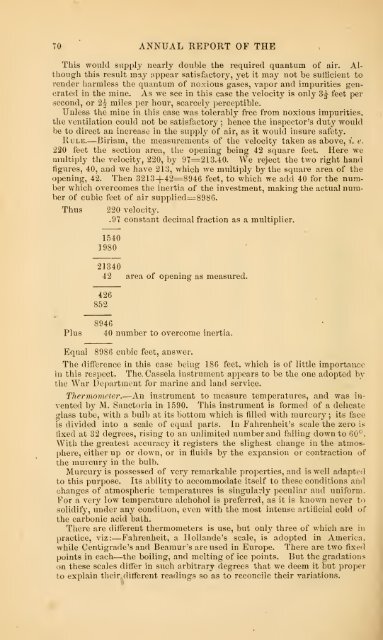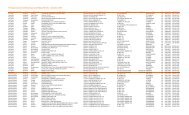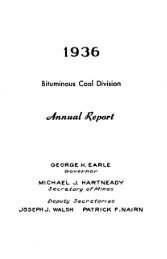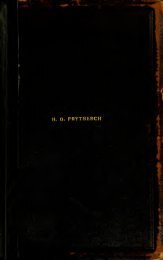1873 - Old Forge Coal Mines
1873 - Old Forge Coal Mines
1873 - Old Forge Coal Mines
Create successful ePaper yourself
Turn your PDF publications into a flip-book with our unique Google optimized e-Paper software.
TO<br />
ANNUAL REPORT OF THE<br />
This would supply nearly double the required quantum of air. Although<br />
this result may appear satisfactory, yet it may not be sufficient to<br />
render harmless the quantum of noxious gases, vapor and impurities generated<br />
in the mine. As we see in this case the velocity is only 3^ feet per<br />
second, or 2^ miles per hour, scarcely perceptible.<br />
Unless the mine in this case was tolerably free from noxious impurities,<br />
the ventilation could not be satisfactory ; hence the inspector's duty would<br />
be to direct an increase in the supply of air, as it would insure safety.<br />
Rule.—Biriam, the measurements of the velocity taken as above, i. e.<br />
220 feet the section area, the opening being 42 square feet. Here we<br />
multiply the velocity, 220, by 97=213.40. We reject the two right hand<br />
figures, 40, and we have 213, which we multiply by the square area of the<br />
opening, 42. Then 3213+42=8946 feet, to which we add 40 for the number<br />
which overcomes the inertia of the investment, making the actual number<br />
of cubic feet of air supplied=8986.<br />
Thus<br />
220 velocity.<br />
1540<br />
1980<br />
.97 constant decimal fraction as a multiplier.<br />
21340<br />
42 area of opening as measured.<br />
426<br />
852<br />
Plus<br />
8946<br />
40 number to overcome inertia.<br />
Equal<br />
8986 cubic feet, answer.<br />
The difference in this case being 186 feet, which is of little importance<br />
in this respect. The. Cassela instrument appears to be the one adopted by<br />
the War Department for marine and land service.<br />
Thermometer.—An instrument to measure temperatures, and was invented<br />
by M. Sanctoria in 1590. This instrument is formed of a delicate<br />
glass tube, with a bulb at its bottom which is filled with murcury ; its face<br />
is divided into a scale of equal parts. In Fahrenheit's scale the zero is<br />
fixed at 32 degrees, rising to an unlimited number and falling down to 60°.<br />
With the greatest accuracy it registers the slighest change in the atmosphere,<br />
either up or down, or in fluids by the expansion or contraction of<br />
the murcury in the bulb.<br />
Murcury is possessed of very remarkable properties, and is well adapted<br />
to this purpose. Its ability to accommodate itself to these conditions and<br />
changes of atmospheric temperatures is singularly peculiar and uniform.<br />
For a very low temperature alchohol is preferred, as it is known never to<br />
solidify, under any condition, even with the most intense artificial cold of<br />
the carbonic acid bath.<br />
There are different thermometers is use, but only three of which are in<br />
practice, viz:— Fahrenheit, a Hollande's scale, is adopted in America,<br />
while Centigrade's and Beamur's are used in Europe. There are two fixed<br />
points in each—the boiling, and melting of ice points. But the gradations<br />
on these scales differ in such arbitrary degrees that we deem it but proper<br />
to explain their different readiugs so as to reconcile their variations.




![1945 Anthracite Annual Report Districts 19 - 25 [Adobe pdf - 9148Kb]](https://img.yumpu.com/50308099/1/190x119/1945-anthracite-annual-report-districts-19-25-adobe-pdf-9148kb.jpg?quality=85)


![1937 Anthracite Annual Report Districts 1 - 11 [Adobe pdf - 9394Kb]](https://img.yumpu.com/43539962/1/190x119/1937-anthracite-annual-report-districts-1-11-adobe-pdf-9394kb.jpg?quality=85)






![1931 Anthracite Annual Report Districts 1 - 11 [Adobe pdf - 8007Kb]](https://img.yumpu.com/39427789/1/190x119/1931-anthracite-annual-report-districts-1-11-adobe-pdf-8007kb.jpg?quality=85)

